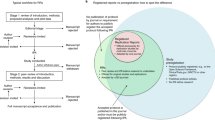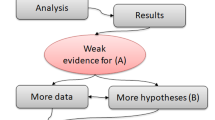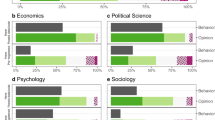Abstract
This paper aims to provide an update on the previous version published towards the end of last year, titled 'BDJ Open (2019-2020) and the advantages of open access publishing'. In this paper, we will highlight articles published throughout 2021, in order to focus on which areas authors felt were important to publish open access and also which areas have been expanded upon in the journal. Furthermore, this paper will examine how open access publishing in BDJ Open has enabled the continuous process of hypothesis testing to be shared more widely, as well as how publishing protocols and early results open access gives strength to that by allowing earlier opportunity for comment by other researchers, both through the peer review process and through further correspondence to authors directly and to the journal editors who publish their work.
Key points
-
Provides an update on the previous 2019-2020 paper by examining articles published in BDJ Open in 2021, to highlight which areas researchers felt were important to publish open access.
-
Highlights the advantages of open access publishing to authors, readers and the scientific community, particularly in light of the ongoing COVID-19 pandemic.
-
Explores how open access publishing in BDJ Open has enabled the continuous process of hypothesis testing to be shared more widely, allowing earlier opportunity for comment by other researchers.
Similar content being viewed by others
Introduction
We recently gave an outline of the different types of paper published in 2019 and 2020 as open access through BDJ Open,1 the online sister journal to the BDJ. As BDJ Open is online-only, there are no constraints in terms of printed pages, and this gives authors the opportunity to publish a wider variety of manuscript types. BDJ Open had its most successful year to date in 2021 with 35 published papers. This paper provides an update on the previous one to outline which areas authors chose to publish as open access in 2021.
This year, it was interesting to note an increase in publications that were pilot studies, study protocols and similar. This is a further advantage of open access publishing; the scientific method involves continuous refinement of hypotheses and publishing protocols and early results by open access gives strength to that. It allows earlier opportunity for comment by other researchers, both through the peer review process and through further correspondence to authors directly and to the journal editors who publish their work.
Unsurprisingly, a number of published papers looked at how the COVID-19 pandemic affected dental practice. Naturally, this was an area of rapidly evolving evidence and, again, open access allowed a way of sharing this new, emerging knowledge widely and quickly, as there are generally shorter wait times for publication in online journals. Published manuscripts, including those related to COVID-19, have been grouped in the same way in this update as in the 2019-2020 version of our review of BDJ Open published articles. This allows for comparisons to be made between the 2019-2020 and the 2021 reviews.
Dental professionals
In 2021, there were five published manuscripts focusing on the experiences of dental professionals (the same yearly average as for 2019-2020).2,3,4,5,6 Just one of these focused on COVID-19 and this came from Nepal.5 This is likely due to the large number of published manuscripts on this topic in the print version of the BDJ (which also has the option for publishing open access). This manuscript, and the manuscript from Senegal on the classification of periodontal diseases,3 are both further examples of where open access publishing allows authors from across the globe to publish their findings.
Patient experience
In 2021 alone, there were eight papers published on the experience of patients,7,8,9,10,11,12,13,14 again from a wide geographical reach including Lima,11 Malaysia7 and India.13 Of these eight, three papers focused on the health and oral health of older adults.10,13,14 This is an indication of the increasing global awareness of this issue.
Pre-clinical/ex vivo
There were just four papers published reporting the results of ex vivo studies.15,16,17,18 These outline early pre-clinical studies of new health technologies (new materials, methods and pharmacological interventions) and in vitro studies of existing technologies. These were relatively more frequent in the early days of BDJ Open, but this journal now covers the whole range of dental research.
Health technology assessment/clinical interventions
There were ten papers published which examined the effectiveness and cost-effectiveness of health technologies and interventions.19,20,21,22,23,24,25,26,27,28 This included a protocol on a study into water fluoridation,20 a scoping review for salivary COVID-19 diagnostics21 and a pilot trial for the use of propolis following head and neck radiotherapy.22 As noted above, print journals such as the BDJ are aimed at a wide readership and are less able to prioritise publishing protocols and early results. These papers are generally published as part of a longer process of knowledge development, as opposed to having generalisable results. Again, open access publishing allows this continuous process of hypothesis testing to be shared more widely.
Epidemiology
There were four papers published in the field of epidemiology,29,30,31,32 which examine the incidence, distribution and possible control of diseases and other factors relating to health. This is the same number for 2019 and 2020 combined and represents a further area of expansion for BDJ Open.
Systematic reviews
There were four systematic reviews published in 2021,33,34,35,36 with just two published in the whole of 2019-2020. BDJ Open is a research journal and so does not currently publish narrative reviews. However, systematic reviews aim to answer a novel question by combining and assessing all the available evidence, and we are very pleased to have published some high-quality systematic reviews in 2021. These are evidently of interest to our readership as the paper by Martin et al.34 reviewing articaine in dentistry was the top accessed paper in BDJ Open in 2021. The paper by Johnson et al.36 on contamination by periodontal procedures was also highly viewed. Systematic reviews such as this one are important as COVID-19 led to a huge increase in submissions to journals worldwide, and systematically reviewing the available literature makes a substantial addition to the knowledge base.
Conclusion
BDJ Open saw its most successful year to date in 2021 with 35 publications. The range and quality of published papers also continues to improve. Further benefits of open access publishing were seen in terms of rapid publication of emerging topics, most notably COVID-19. An increase in publication of early results and study protocols is also encouraging in adding to the available evidence base. By no means are all submitted manuscripts accepted for publication, and the editorial team would like to thank all authors who have submitted manuscripts for consideration. We would also like to express sincere thanks to the large number of referees required to publish 35 papers in a research-only journal.
Further information for potential authors or referees can be found at https://www.nature.com/bdjopen/authors-and-referees.
References
Lewney J. BDJ Open (2019-2020) and the advantages of open access publishing. Br Dent J 2021; 231: 713-715.
Milosavljevic A, Wolf E, Englander M, Stavropoulos A, Götrick B. The lived experience of performing a periodontal treatment in the context of general dentistry. BDJ Open 2021; DOI: 10.1038/s41405-021-00059-4.
Bakari W N, Thiam D, Mbow N L et al. New Classification of Periodontal diseases (NCPD): an application in a Sub-Saharan country. BDJ Open 2021; DOI: 10.1038/s41405-021-00071-8.
Alrowaili E F. Self-Reported Knowledge about Dental Caries at Young Age and Variations between Dental Practitioners in the Ministry of Health in Bahrain. BDJ Open 2021; DOI: 10.1038/s41405-021-00073-6.
Pandey N, Basnet B B, Koju S, Khapung A, Gupta A. Awareness of Aerosol related transmission of COVID-19 among the Dentists of Nepal. BDJ Open 2021; DOI: 10.1038/s41405-021-00079-0.
Grazziotin-Soares R, Blue C, Feraro R et al. The interrelationship between confidence and correctness in a multiple-choice assessment: pointing out misconceptions and assuring valuable questions. BDJ Open 2021; DOI: 10.1038/s41405-021-00067-4.
Tay K, Beh C L J, Babar M G, Kweh T J, Priya E, Pau A. Racial Variations in Tooth Pain and Care-Seeking in Adolescents in Malaysia. BDJ Open 2021; DOI: 10.1038/s41405-021-00058-5.
Desai R, Khobaragade B, McCracken G et al. Impact of diabetes and periodontal status on life quality. BDJ Open 2021; DOI: 10.1038/s41405-021-00061-w.
Sun Y, Li C, Zhao Y, Sun J. Trends and Development in Oral Health Literacy: A Scientometric Research Study (1991-2020). BDJ Open 2021; DOI: 10.1038/s41405-021-00066-5.
Patel R, Mian M, Robertson C, Pitts N B, Gallagher J E. Crisis in care homes: the dentists don't come. BDJ Open 2021; DOI: 10.1038/s41405-021-00075-4.
Opazo-García C, Moya-Salazar J, Chicoma-Flores K, Contreras-Pulache H. Oral health problems in High-Performance Athletes at 2019 Pan American Games in Lima: A descriptive study. BDJ Open 2021; DOI: 10.1038/s41405-021-00078-1.
Hagman J, Wide U, Werner H, Hakeberg M. Oral Health and Oral Health Behavior in Young Adults with Caries Disease. BDJ Open 2021; DOI: 10.1038/s41405-021-00084-3.
Rodrigues A, Dhanania S, Rodrigues R. "If I have teeth, I can smile." Experiences with tooth loss and the use of a removable dental prosthesis among people who are partially and completely edentulous in Karnataka, India. BDJ Open 2021; DOI: 10.1038/s41405-021-00088-z.
Kc S, Aulakh M, Curtis S, Scambler S, Gallagher J E. Perspectives of community-dwelling older adults with dementia and their carers regarding their oral health practices and care: rapid review. BDJ Open 2021; DOI: 10.1038/s41405-021-00091-4.
Hidalgo J, Baghernejad D, Falk A, Larsson C. The influence of two different cements on remaining cement excess in cement-retained implant-supported zirconia crowns. An in-vitro study. BDJ Open 2021; DOI: 10.1038/s41405-021-00063-8.
Aburaisi S, Basha A, Al Najjar K, Al Saqat H, Al Askar F, Al Nazer F. The Colour Stability of Crystallized Acetyl Resin Material in Comparison to other Restorative Materials. An in-vitro study. BDJ Open 2021; DOI: 10.1038/s41405-020-00055-0.
Mansour F K, Ibrahim R M, Mansour H, Hamdy A M. Assessment of Internal fit and Micro leakage of conventionally fabricated ceramometallic restoration versus CAD wax and press veneering (In-vitro Study). BDJ Open 2021; DOI: 10.1038/s41405-021-00072-7.
Rahman F A. Gene expression profiling on effect of aspirin on osteogenic differentiation of periodontal ligament stem cells. BDJ Open 2021; DOI: 10.1038/s41405-021-00090-5.
Broeke L V, Grillon M, Yeung A W K, Wu W, Tanaka R, Vardhanabhuti V. Feasibility of photon-counting spectral CT in dental applications A comparative qualitative analysis. BDJ Open 2021; DOI: 10.1038/s41405-021-00060-x.
Moore D, Allen T, Birch S, Tickle M, Walsh T, Pretty I A. How effective and cost-effective is water fluoridation for adults? Protocol for a 10-year retrospective cohort study. BDJ Open 2021; DOI: 10.1038/s41405-021-00062-9.
Kapoor P, Chowdhry A, Kharbanda O P, Popli D B, Gautam K, Saini V. Exploring Salivary Diagnostics in COVID-19: A Scoping Review and research suggestions. BDJ Open 2021; DOI: 10.1038/s41405-021-00064-7.
Nakao R, Ueno T. Effects of Oral Moisturizing Gel Containing Propolis Following Head and Neck Radiotherapy: Randomized Controlled Pilot Trial. BDJ Open 2021; DOI: 10.1038/s41405-021-00068-3.
Mitchell C, Zaku H, Milgrom P, Mancl L, Prince D B. The accuracy of laser fluorescence (DIAGNOdent) in assessing caries lesion activity on root surfaces, around crown margins, and in furcations in older adults. BDJ Open 2021; DOI: 10.1038/s41405-021-00069-2.
Mohan A, Sivakumar A, Nalabothu P. Evaluation of accuracy and reliability of OneCeph digital cephalometric analysis in comparison with manual cephalometric analysis - A cross-sectional study. BDJ Open 2021; DOI: 10.1038/s41405-021-00077-2.
Amaechi B T, Lemke K C, Saha S, Luong M N, Gelfond J. Clinical Efficacy of Nanohydroxyapatite-Containing Toothpaste at Relieving Dentin Hypersensitivity: An 8 Weeks Randomized Control Trial. BDJ Open 2021; DOI: 10.1038/s41405-021-00080-7.
Creeth J E, Goyal C, Qaqish J, Maclure R, Holt J S. Efficacy of an occluding toothpaste on dentinal hypersensitivity over 14 days. BDJ Open 2021; DOI: 10.1038/s41405-021-00076-3.
Baireddy R J, Cook N, Li S, Barrak F. Does immediate loading of a single implant in the healed anterior maxillary ridge improve the aesthetic outcome compared to conventional loading. BDJ Open 2021; DOI: 10.1038/s41405-021-00083-4.
Graetz C, Düffert P, Heidenreich R, Seidel M, Dörfer D E. The efficacy of an extraoral scavenging device on reducing aerosol particles ≤5 μm during dental aerosol-generating procedures: an exploratory pilot study in a university setting. BDJ Open 2021; DOI: 10.1038/s41405-021-00074-5.
Li W, Lipsky M S, Hon E S et al. Predicting all-cause 90-day hospital readmission for dental patients using machine learning methods. BDJ Open 2021; DOI: 10.1038/s41405-021-00057-6.
Chetty M, Roomaney I A, Beighton P. Taurodontism in Dental Genetics. BDJ Open 2021; DOI: 10.1038/s41405-021-00081-6.
Thomas N, Kay E, Witton R, Quinn C. Comparison of a full arch digital photographic assessment of caries prevalence in 5-year-old children to an established visual assessment method: A cross sectional study. BDJ Open 2021; DOI: 10.1038/s41405-021-00087-0.
Kubota Y, Pech N S, Durward C, Ogawa H. Underweight and Early Childhood Caries among Young Children in Rural Cambodia: a pilot study. BDJ Open 2021; DOI: 10.1038/s41405-021-00089-y.
Beecher D, James P, Browne J, Di Blasi Z, Harding M, Whelton H. Dental patient reported outcome and oral health-related quality of life measures: protocol for a systematic evidence map of reviews. BDJ Open 2021; DOI: 10.1038/s41405-021-00065-6.
Martin E, Nimmo A, Lee A, Jennings E. Articaine in dentistry: An overview of the evidence and meta-analysis of the latest randomised-controlled trials on articaine safety and efficacy compared to lidocaine for routine dental treatment. BDJ Open 2021; DOI: 10.1038/s41405-021-00082-5.
Abdelhay N, Prasad S, Gibson M P. Failure Rates Associated with Guided Versus Non-Guided Dental Implant Placement: A Systematic Review and Meta-Analysis. BDJ Open 2021; DOI: 10.1038/s41405-021-00086-1.
Johnson I G, Jones R J, Gallagher J E et al. Dental Periodontal Procedures: A systematic review of contamination (splatter, droplets and aerosol) in relation to COVID-19. BDJ Open 2021; DOI: 10.1038/s41405-021-00070-9.
Author information
Authors and Affiliations
Corresponding author
Ethics declarations
The author declares no conflicts of interest.
Rights and permissions
About this article
Cite this article
Lewney, J. BDJ Open 2021 - our most successful year to date. Br Dent J 232, 744–746 (2022). https://doi.org/10.1038/s41415-022-4197-7
Published:
Issue Date:
DOI: https://doi.org/10.1038/s41415-022-4197-7



